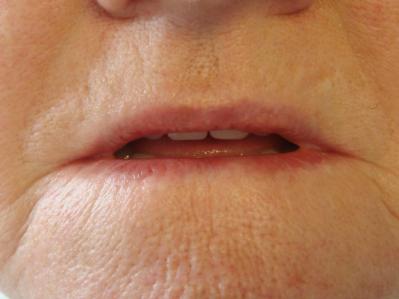This client attended my clinic requesting advice relating to eating and appearance. As is illustrated in fig 1 in the dentures were in excess of 30years old and were obtained through the national health service. The denture teeth in these days were cross-linked acrylic and were moderatly wear resistant.
Today the tooth materials on the quality private market are obtainable in double crossed linked and include composite and nano particles to inpart high wear resistant in severe oral saliva conditions.
This element is imperative if the vertical face height is to be maintained. The Vertical face height in millimetres is measurable from under the chin to under the nose and is specific to the individual. This position is maintained 'static' using the natural teeth. When they are missing then denture teeth should take over this role. Maintenance of this role is imperative if damage to the temperomandibular joints near the ears is to be avoided. This damage can result in clicking and grinding when opening and closing the jaw and during function.
See partial denture updates for VFH suport ie additon of back teeth for VFH support.
You will observe that the lower teeth have occupied a protrusive relationship to the upper teeth. This relationship becomes an 'acquired' position. Not evident on this photograph is the fact that the upper and lower back teeth do not actually touch each other.
The lower jaw is then free to protrude in an attempt to find back teeth occlusion. In the earlier days of wear this protrusion would have been slight and the client would have been unaware of the changes that were taking place.
With the correction of the VFH and the intercuspation presant in fig 4 the new relationship has been installed in line with the oral muscles.
Any change must be controlled and the degree of change needs careful monitoring otherwise the client will reject the dentures on the basis that they are 'too big'. In actual fact, they are saying is the change is too dramatic.
As you will probably observe when comparing fig 2 to fig 5, the front uper centrals reveal no wear and indeed the new central position was placed in the corresponding position to that of the previous dentures. The change that took place at the front of the mouth was that of raising the front lower teeth.
In fig 4 the lower front teeth were retracted slightly to exhibit a normal class1 relationship. This is also advisable as excessive lip pressure can inadvertently result in the lower denture lifting during rest and talking
Figure 3 illustrates the relationship of the upper and lower teeth in solid occlusion and to illustrate the true position I had to take the photograph aiming it downwards to illustrate the massive degree of negative overbite present.
I have over the years found that clients with this presenting appearance respond successfully to the required change and are likewise appreciative of the minimum changes necessary. This is 100% achieveable using the 'Copy Technique'.
1. Appearance is readily restored.
2. Coherent speech is resumed due to an increase in inter-oral room for tongue movement during it's multi positions necessary for pronounciation.
3. Swallowing is improved as again the tongue is able to move saliva to the back of the mouth for swallowing.
4. Cutting and chewing function: clients have reported that it is effortless with the new dentures compared with the previus set. Again the tongue is not tongue tied as it was in the over 'closed' jaw relationship of the previous dentures.
5. The grinding of food is now efficient as the cusps on the new denture teeth are now present, and if made with quality Ivoclar DCL back teeth will be efficient at chewing for many years. This lady found it very difficult to eat with her previous dentures as the cutting angles were non existant. Eating out socially was a 'night mare'.
Fig 1. Client recorded posteriorally in the correct vertical face height relationship. As is evident the wear of the canines area and bicuspids is dramatic.
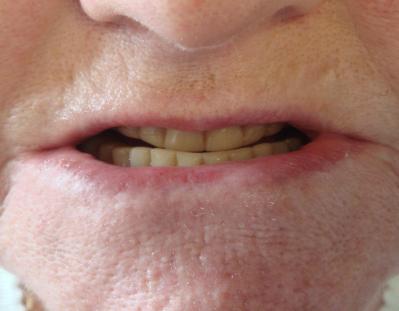
Fig 2
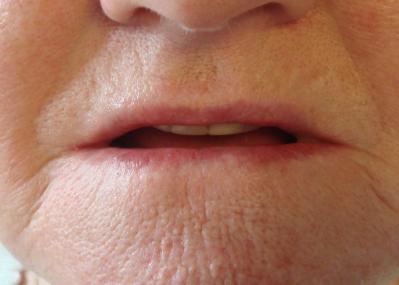
Fig 3 Occluded relationship of the dentures following the reduction in vertical suppoert due to wear and tear of the back teeth.
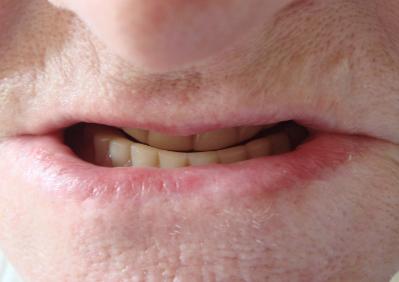
Fig. 4 Client restored to her former glory and was openly surprised.
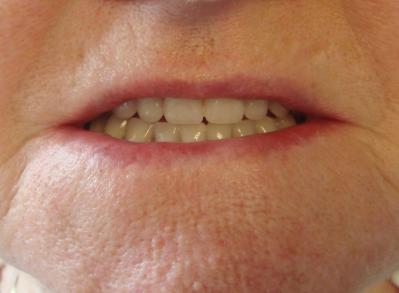
Fig 5
